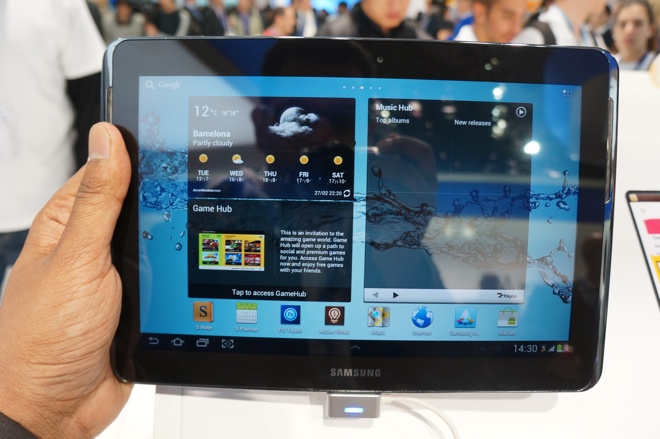Let me say this up front: If you’ve held out for a tablet, Apple’s new iPad is the one to get. But if you’re an iPad 2 owner and perfectly content with its lesser screen, the decision to upgrade is much tougher.
Yet again, Apple is basically competing with itself in the tablet arena. Android tablets, aside from the cheap $199 Kindle Fire, continue to bombard consumers with features (Quad core processors! Flash support!), while offering a noticeably less functional experience than the iPad for around the same price (and often more). Android is only now beginning to find its footing on tablets, and there still aren’t nearly enough Android tablet apps out there (more on this below). Other tablet competitors, like the BlackBerry PlayBook, are barely worth a mention.
This time around, Apple wisely chose to focus on the spec that matters most on a tablet: the screen. The iPad’s new Retina Display — so named because its high resolution practically makes pixels disappear — is the new standard by which all future displays will be measured.
I’ve already written a short love letter to the Retina Display, but it’s hard to overstate just how good this screen is. On the other hand, if you’re avoiding the urge to buy the new iPad, you should try to avoid seeing it in person.
The Good: It’s all about the Retina Display
Above: iPad Safari icon comparison: iPad 2 on left, new iPad with Retina Display on right
Despite being massive hits, Apple’s previous iPads were cursed with a surprisingly low screen resolution: 1024 by 768, or about what computer monitors offered over 10 years ago. The resolution deficiency was remedied somewhat by the iPad’s 9.7-inch screen, but as Android tablets began to reach higher resolutions (enough to support 720p high-def video), the iPad’s pixels began to show (see right).
To put it simply, the Retina Display makes the new iPad look better than its predecessors. In fact, it looks better than any computer display you’ve ever seen. Its 2048 by 1536 resolution means it can play 1080p HD video with pixels to spare. When viewed at a typical distance (around 15-inches from your face), you can’t see any pixels on the new iPad’s screen. That leads to an overall better viewing experience for just about everything.
More so than a fancy new quad-core processor (the new iPad still rocks a dual-core CPU, though its A5X processor features faster graphics), the Retina Display is an upgrade that is immediately noticeable to just about anyone. It’s a particularly significant addition since it finally makes the iPad the best at something. No other device offers the Retina Display’s high resolution in such a small amount of space — which ultimately makes it a joy to look at.
I’ll acknowledge that I’m something of a display junky. The Retina Display has gotten me more excited than the move from DVD to HD discs, but I doubt many consumers will get goosebumps over a resolution change. When viewed side-by-side with other tablets in stores, though, the superiority of the new iPad’s screen would be evident to just about everyone.
But there’s more to the new iPad than just the screen. It also marks the first time Apple has offered a 4G LTE mobile device, and its slightly faster processor now features quad-core graphics, which will be a boon for gaming.
Unfortunately, I didn’t have a chance to test out the LTE version of the iPad. But judging from the fast download speeds others are seeing — between 10 megabits per second and 25 Mbps on both Verizon and AT&T’s 4G networks — it looks like the LTE connectivity is well worth the extra cost. Even better, the iPad has built-in 4G hotspot capabilities at no extra charge — so you can easily use it to get your laptop online. The iPad isn’t the first tablet to get LTE, but it’s the first to offer it without a complicated contract.

Above: Infinity Blade 2 on the new iPad
I spent a good chunk of the last weekend “testing out” the new iPad’s improved graphics with popular titles like Infinity Blade 2 and Galaxy on Fire 2 HD. The improvements are noticeable: textures have more detail, and the games sport more eye-candy overall. The upgraded graphics were also a necessity, since you need more horsepower to run games at higher resolutions. That’s also the reason Apple chose to include 1 gigabyte of RAM in the new iPad — twice that of the iPad 2.
Speaking of performance, I’m not sure if it’s due to the faster graphics or increased RAM, but there’s a definite confidence in the new iPad’s performance. Launching and moving between apps is effortless, there’s none of the slowdown that we often expect from mobile devices. It may not be a huge upgrade over the iPad 2’s performance, but compared to lesser tablet competitors, it’s miles ahead.
The new iPad also sports an improved 5 megapixel rear camera, which can take 1080p HD video. It’s a massive improvement over the iPad 2’s shooter (not a huge win, since that camera was notoriously bad), but for some reason Apple still hasn’t upgraded the front-facing iSight camera.
The bad: Slightly heavier, not ideal for movies
Given that this is Apple’s third stab at refining its tablet, the new iPad has few negatives. It’s slightly heavier than the iPad 2 (to account for a larger battery), but the difference is something only iPad 2 owners will notice. In my messenger bag, it still feels as portable as its predecessor, and it’s nowhere near as bulky as the first iPad.
Holding up the new iPad with one hand strained my wrist slightly more than the iPad 2 did, which could be a problem for longer reading sessions. (Time for the long-rumored smaller iPad, anyone?)
Those looking for a completely new iPad design will be disappointed, as the new iPad is virtually indistinguishable from the iPad 2. As some of the pictures below show, the new iPad is slightly thicker, but you’d really have to look close to notice that. It also features a slightly more tapered rear, which made it a bit easier to hold than past versions.
One nagging problem about the new iPad is its 4:3 screen ratio. When it comes to browsing the web and reading text, it’s not much of an issue. But when you’re watching movies, the screen aspect has trouble fitting widescreen films. The issue is particularly pronounced with widescreen films using the 2.35:1 aspect ratio — a format so wide that it still makes black bars appear on widescreen HDTVs.
The new iPad is perfectly fine for most films, but for those using the more cinematic 2.35:1 format, it’s simply frustrating. Again, this is a problem that has plagued the iPad since the beginning — it’s simply not an ideal movie viewing device, even though it can now play Blu-ray quality films. (And yes, you can zoom into the video by double-tapping, but as a cinephile I find that blasphemous.)
New iPad vs. Android tablets
 My biggest takeaway from using the new iPad? It feels so much better than any Android tablet that I’ve tested (and that’s a lot of tablets), that it’s sort of embarrassing for Google.
My biggest takeaway from using the new iPad? It feels so much better than any Android tablet that I’ve tested (and that’s a lot of tablets), that it’s sort of embarrassing for Google.
The big difference is in how Apple and Google are approaching tablets. Apple is pushing the iPad as an entirely different platform from the iPhone, with apps that cater to its larger screen.
Android tablet makers like Samsung, on the other hand, initially just recreated the Android phone experience on slates. That was mostly Google’s fault, since Android wasn’t optimized for tablets until Android 3.0 “Honeycomb.” With that release came a few Android apps targeted at tablets, but it was still nowhere near the app frenzy that the iPad has seen.
For any mobile platform, it all comes down to the apps: Apple has pushed developers to create iPad apps, and the general success of the platform is also luring developers to upgrade their apps as well. There are now over 200,000 iPad apps available on the App Store, out of a total of 550,000 iOS apps. Meanwhile, there are only a relative handful of Android tablet apps available. (I haven’t seen an exact count of Android tablet apps lately, but from browsing around Google Play, I figure there are a few hundred.)
Google’s Android head Andy Rubin said the company is aiming to “double-down” on tablets this year, but unless Google fundamentally rethinks how it’s approaching tablets and developers, I don’t have much hope for the future of Android slates. (Microsoft may have a stronger iPad competitor right out the gate with Windows 8.)
Honestly, even the iPad 2 offers a better experience than any Android tablet I’ve seen, even with its slightly lower specs. But the new iPad’s Retina Display, as well as its faster graphics, put it on another level entirely.
The level of polish in the new iPad puts every Android tablet to shame, and it’s a clear sign that many Android tablet makers should just give it up already. Android will continue to shine in the low-end market, with devices like the Kindle Fire, but you’d be hard-pressed to consider those direct competitors to the iPad.
Wrapping up: the best tablet yet
What’s most remarkable about the new iPad is that it has finally won me over. I’ve never been a big fan of tablets in general, but now that there’s a slate with a screen that’s significantly better than any other display I’ve seen, I have a reason to reach for my iPad instead of my MacBook Pro, iPhone, or Kindle.
I liked the iPad 2, but it was never able to find its way into my daily workflow. The new iPad, on the other hand, is something I now prefer to use for general web browsing or reading long documents.
The Retina Display, instead of just being a smart marketing ploy, truly makes all the difference.
Specs at a glance
- Dual-core A5X processor with quad-core graphics
- 2048 by 1536 9.7-inch Retina Display
- 1GB RAM
- LTE 4G, HSPA+ compatible
- 5 megapixel rear camera, VGA front camera
- Price: Starting at $499 for 16GB with Wi-Fi, $629 for 16GB with LTE
Photos: Devindra Hardawar/VentureBeat (unless otherwise noted)
VentureBeat is holding its second annual MobileSummit this April 2-3 in Sausalito, Calif. The invitation-only event will debate the five key business and technology challenges facing the mobile industry today, and participants — 180 mobile executives, investors, and policymakers — will develop concrete, actionable solutions that will shape the future of themobile industry. You can find out more at our Mobile Summit site.

